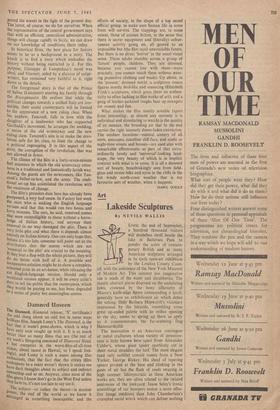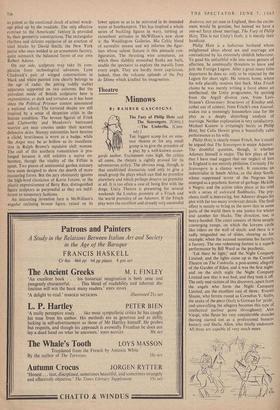Art
Lakeside Sculptures
By NEVILE WALLIS
UNTIL the end of September, a hundred thousand visitors will doubtless stroll beside the lake in Battersea Park to ponder the score of contem- porary British and as many American sculptures arranged in its sixth open-air exhibition by the London County Coun- cil, with the assistance of the New York Museum of Modern Art. This summer less imaginative use is made of the water and shrubberies. The mostly abstract pieces disposed on the undulating lawn, crowned by the bony silhouette of Moore's knife-edge figure commanding a knoll, generally have an exhibitionist air which defies the setting. Only Barbara Hepworth's visionary monument by the lakeside, resembling some great up-ended palette with its orifice opening to the sky, seems to spring up there as aptly as it commemorates the far-scanning Dag Hammarskjold.
The innovation is an American contingent of metal craftsmen whose variety of inventive- ness is little known here apart from Alexander Calder's, whose giant spider sportively cut in sheet metal straddles the turf. The most elegant (and only mobile) conceit comes from a New Yorker, George Rickey. His sheaf of tapering spears pivoted at the base and clinking in the gusts of air has the flash of reeds swaying in high summer. Idiosyncratic as these American works are, they are often related to the twisted anatomies of the junkyard. Jason Seley's ironic assemblage of car bumpers makes a more effec- tive image outdoors than John Chamberlain's crumpled metal wreck which can deliver nothing as potent as the emotional shock of actual wreck- age piled up by the roadside. The only effective contrast to the Americans' fantasy is provided by their geometric constructions. The rectangular rhythms and delicate equipoise of an erection of steel blocks by David Smith, the New York purist who once welded in an armaments factory, quite outmatch the balanced forms of our own Robert Adams.
On our side, sculpture may take its com- plexion from technological advances. Lynn Chadwick's pair of winged constructions in black and white painted iron clearly belongs to the age of radar, the jutting (oddly stable) apparatus supported on two columns. But the prevalent mode of British sculptures here is expressionist, as dark and tortuous as it has been since the Political Prisoner contest announced a national school. The tortured shapes are still inspired by a sense of desperate crisis in the human condition. The bronze figures of Frink and Clatworthy and Meadows's buttressed warrior are near cousins under their scarred, defensive skins. Stumpy extremities have become a clichd, brutishness is worn as a badge, while the Angst may be as hollow as its manifesta- tion in Ralph Brown's repulsive cleft woman. The cult of this northern romanticism is pro- longed because it still exhibits a native co- herence, though the vitality of the Fifties is spent. Two pieces of sentimental garden statuary here seem designed to show the dearth of more reassuring forms. But the jury obstinately ignores the high-bred classicism of Karin Jonzen, or the plastic expressiveness of Betty Rea, distinguished figure sculptors as purposeful as they are indif- ferent to temporary fashions.
An interesting invention here is McWilliam's angular reclining bronze figure, raised on its lower apices so as to be mirrored in its intended water at Southampton. This has inspired a whole series of buckling figures in wary, turning or recumbent attitudes in McWilliam's new show at the Waddington Galleries. His Celtic blend of surrealist unease and wit informs the figur- ines whose salient feature is this pinnacle con- figuration. The thrusting wire armatures, on which these slabbily enmeshed flanks are built, enable the spectator to explore the massifs from every angle. They are hardly more capricious, indeed, than the volcanic uplands of the Puy de Dome which kindled his imagination.











































 Previous page
Previous page